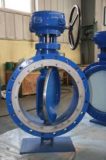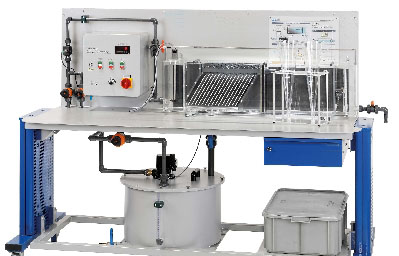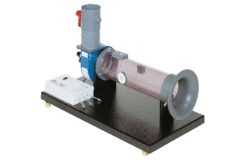Separation in Sedimentation Tank Apparatus Model FM 128
Home » Products » Separation in Sedimentation Tank Apparatus Model FM 128
Separation in Sedimentation Tank Apparatus Model FM 128
Sci-tech Separation in Sedimentation Tank Apparatus Model FM 128 makes it possible to investigate the separation of solids from a suspension in a sedimentation tank.
Item Description
In sedimentation tanks, solids are separated out from suspensions under the influence of gravity. In this process the density of the solid particles must be greater than that of the liquid.
First a concentrated suspension is prepared in a tank, comprising water and the solid to be separated. A pump transports the concentrated suspension to the sedimentation tank. Upstream of the sedimentation tank the suspension is mixed with fresh water. The raw water generated in this way flows into the sedimentation tank via an inlet weir. A stirring machine is located upstream of the inlet weir. This prevents solids sediments before entering the sedimentation tank. The treated water first flows under a baffle and then over a weir to the outlet. The height of the weir on the outlet side is adjustable and allows the water level in the sedimentation tank to be changed. The water level above the inlet weir can also be adjusted. This affects the flow velocity over the inlet weir.
A lamella unit can be inserted into the experimental section. This makes it possible to study how lamellas affect the separation process. The flow through the lamellas occurs from bottom to top. Above the lamellas is an outlet channel. The side walls of the outlet channel are designed as a serrated weir. The flow rates of the concentrated suspension and the fresh water are adjusted via valves. This means the mixing ratio, and thus the concentration of solids in the inlet to the sedimentation tank, can be adjusted. An electromagnetic flow rate sensor measures the flow rate in the inlet of the sedimentation tank. Flow rate and speed of the stirring machine are displayed digitally. The sedimentation tank is equipped with lighting to better observe the flow conditions.
Features
Transparent sedimentation tank for observation of the separation process
Illumination for optimum visualization of the flow conditions
Possible to use lamellas in the sedimentation tank
Technical Specifications
Specifications
1. Separation of suspensions by sedimentation in the sedimentation tank
2. Transparent sedimentation tank with lighting for visualization of the flow conditions
3. Stirring machine in the inlet area of the sedimentation tank
4. Lamella unit can optionally be inserted into the sedimentation tank
5. Tank with pump to create and transport a concentrated suspension
6. Mixture of the concentrated suspension with fresh water gives the raw water to be studied
7. Adjustment of the concentration of solids via valves for fresh water flow rate and suspension flow rate
8. Adjustable water level in the sedimentation tank and adjustable flow velocity in the inlet
9. Electromagnetic flow rate sensor for raw water
10. Imhoff cones for determining settleable substances of a water sample
Technical Specifications
Sedimentation tank (experimental section)
LxWxH: 900x110x300mm
max. filling capacity: approx. 25L
material: clear acrylic
Lamella unit
angle of inclination of lamellas: 60°
Suspension tank
capacity: approx. 85L
material: stainless steel
Pump
max. flow rate: 70L/min
max. head: 6m
Stirring machine
max speed: 330min-1
Measuring ranges
flow rate: 30…600L/h
speed: 0…330min-1
Experiments:
basic principle for the separation of solids from suspensions in a sedimentation tank
determine the hydraulic loading rate
influence of the following parameters on the separation process:
concentration of solids
flow rate
flow velocity in the inlet
water level in the sedimentation tank
investigation of the flow conditions
how lamellas affect the sedimentation process
Requirements
Mains Power 220 – 240V @ 50Hz, 1Ph
See also different:

The Sci-tech Cavitation Demonstration Apparatus Model FM 19 is a compact bench top unit and has been designed to visualize and study the cavitation phenomenon in water flow. The apparatus consists of a venturi - shaped test section made of cle [...]

Sci-tech Butterfly Valve & Non-Return Valve Assembly Model FMSC-BVNR are used where flow reversal is not permitted. They must fully seal off the reverse direction while offering the lowest possible resistance in the forward flow direction. [...]


